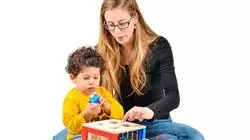University certificate
The world's largest faculty of education”
Introduction to the Program
The work of the Educational Psychologist has gained strength, gaining traction in educational institutions. Get up to date with the most developed knowledge in this area and don't be left behind"

Psychopedagogy has reached, by its own merits, a place of recognition in the current scientific panorama. The knowledge of this discipline has become the subject of articles, monographs, and publications at international level that have shaped a panorama of great interest for the professional. These developments have led to advances in techniques, disciplines and modes of observation and intervention that make it essential for professionals to continually update their knowledge and skills.
This increasingly broad qualification is of inestimable value in the Educational Center. The diversity of the student body, the new social circumstances, the new educational challenges, the vertiginous evolution of cultural contexts, and many other challenges, require the greatest skills from the professionals of Educational Psychopedagogy.
From the intervention point of view, mediation with families has also become increasingly important. The incursion of new technologies in social, school or family life; sexual diversity in the classroom; functional diversity or any of the new paradigms are not static, but evolve at all times and require a competent view that supports, guides and serves as a reference and, in turn, has adequate professional support.
A complete panorama of intense challenges that we try to help you face in this complete training, through the most complete human and technological means, that will allow you to advance in a confident, comfortable and efficient way.
Prepare yourself for the challenges of a constantly evolving area of work and give your CV an unstoppable boost towards competitiveness"
This Professional master’s degree in Educational Psychopedagogy contains the most complete and up-to-date program on the market. The most important features include:
- Practical cases presented by Psychopedagogy experts
- Graphic, schematic, and eminently practical content with which they are conceived
- New developments on Educational Psychopedagogy
- Practical exercises where the self-evaluation process can be carried out to improve learning
- Algorithm-based interactive learning system for decision-making in the situations that are presented to the student
- Evidence-based methodologies in Educational Psychopedagogy
- Theoretical lessons, questions to the expert, debate forums on controversial topics, and individual reflection assignments
- Content that is accessible from any fixed or portable device with an Internet connection
The most advanced forms of Intervention and resources for psychological support and guidance, in a Professional master’s degree created especially for professionals in the school environment"
The teaching staff of the Professional master’s degree in Educational Psychopedagogy is made up of professionals in the sector, who contribute their knowledge and experience to this program in order to produce quality content, as well as recognized specialists belonging to reference societies and prestigious universities.
The multimedia content has been elaborated with the latest educational technology, which will provide the professional with situated and contextual learning, through which the student will be able to study in a simulated environment in which they will be able to study in real situations.
The design of this program is based on Problem-Based Learning, so that the professional will have to try to solve the different situations of professional practice that arise throughout the course. To do so, they will have the help of an Innovative interactive video system created by recognized and experienced experts in the field of Educational Psychopedagogy.
A quality Professional master’s degree, created by experts in the field, who will put their professional and teaching experience at your service to accompany you throughout your preparation"

A program created to allow you to combine your studies with other commitments, smoothly and comfortably, without having to give anything up"
Why study at TECH?
TECH is the world’s largest online university. With an impressive catalog of more than 14,000 university programs available in 11 languages, it is positioned as a leader in employability, with a 99% job placement rate. In addition, it relies on an enormous faculty of more than 6,000 professors of the highest international renown.

Study at the world's largest online university and guarantee your professional success. The future starts at TECH”
The world’s best online university according to FORBES
The prestigious Forbes magazine, specialized in business and finance, has highlighted TECH as “the world's best online university” This is what they have recently stated in an article in their digital edition in which they echo the success story of this institution, “thanks to the academic offer it provides, the selection of its teaching staff, and an innovative learning method aimed at educating the professionals of the future”
A revolutionary study method, a cutting-edge faculty and a practical focus: the key to TECH's success.
The most complete study plans on the university scene
TECH offers the most complete study plans on the university scene, with syllabuses that cover fundamental concepts and, at the same time, the main scientific advances in their specific scientific areas. In addition, these programs are continuously being updated to guarantee students the academic vanguard and the most in-demand professional skills. In this way, the university's qualifications provide its graduates with a significant advantage to propel their careers to success.
TECH offers the most comprehensive and intensive study plans on the current university scene.
A world-class teaching staff
TECH's teaching staff is made up of more than 6,000 professors with the highest international recognition. Professors, researchers and top executives of multinational companies, including Isaiah Covington, performance coach of the Boston Celtics; Magda Romanska, principal investigator at Harvard MetaLAB; Ignacio Wistumba, chairman of the department of translational molecular pathology at MD Anderson Cancer Center; and D.W. Pine, creative director of TIME magazine, among others.
Internationally renowned experts, specialized in different branches of Health, Technology, Communication and Business, form part of the TECH faculty.
A unique learning method
TECH is the first university to use Relearning in all its programs. It is the best online learning methodology, accredited with international teaching quality certifications, provided by prestigious educational agencies. In addition, this disruptive educational model is complemented with the “Case Method”, thereby setting up a unique online teaching strategy. Innovative teaching resources are also implemented, including detailed videos, infographics and interactive summaries.
TECH combines Relearning and the Case Method in all its university programs to guarantee excellent theoretical and practical learning, studying whenever and wherever you want.
The world's largest online university
TECH is the world’s largest online university. We are the largest educational institution, with the best and widest online educational catalog, one hundred percent online and covering the vast majority of areas of knowledge. We offer a large selection of our own degrees and accredited online undergraduate and postgraduate degrees. In total, more than 14,000 university degrees, in eleven different languages, make us the largest educational largest in the world.
TECH has the world's most extensive catalog of academic and official programs, available in more than 11 languages.
Google Premier Partner
The American technology giant has awarded TECH the Google Google Premier Partner badge. This award, which is only available to 3% of the world's companies, highlights the efficient, flexible and tailored experience that this university provides to students. The recognition as a Google Premier Partner not only accredits the maximum rigor, performance and investment in TECH's digital infrastructures, but also places this university as one of the world's leading technology companies.
Google has positioned TECH in the top 3% of the world's most important technology companies by awarding it its Google Premier Partner badge.
The official online university of the NBA
TECH is the official online university of the NBA. Thanks to our agreement with the biggest league in basketball, we offer our students exclusive university programs, as well as a wide variety of educational resources focused on the business of the league and other areas of the sports industry. Each program is made up of a uniquely designed syllabus and features exceptional guest hosts: professionals with a distinguished sports background who will offer their expertise on the most relevant topics.
TECH has been selected by the NBA, the world's top basketball league, as its official online university.
The top-rated university by its students
Students have positioned TECH as the world's top-rated university on the main review websites, with a highest rating of 4.9 out of 5, obtained from more than 1,000 reviews. These results consolidate TECH as the benchmark university institution at an international level, reflecting the excellence and positive impact of its educational model.” reflecting the excellence and positive impact of its educational model.”
TECH is the world’s top-rated university by its students.
Leaders in employability
TECH has managed to become the leading university in employability. 99% of its students obtain jobs in the academic field they have studied, within one year of completing any of the university's programs. A similar number achieve immediate career enhancement. All this thanks to a study methodology that bases its effectiveness on the acquisition of practical skills, which are absolutely necessary for professional development.
99% of TECH graduates find a job within a year of completing their studies.
Professional Master's Degree in Educational Psychopedagogy
Our Professional Master's Degree in Educational Psychopedagogy is an excellent qualification option for all professionals interested in expanding their academic horizons through high quality programs. Through our training you will venture into one of the areas with the best projection for the educational field, because through this discipline you will acquire an updated view on the way in which the new generations are educated. In addition, this program of TECH Global University has the most complete and innovative curriculum in the educational market, as it trains teachers to carry out a competent accompaniment in which they use digital tools as the axis of sustainable development of the student.
Postgraduate in Educational Psychopedagogy 100% online
During 1,500 academic hours you will be able to know in depth the psychological theories that govern the pedagogical field today, thus obtaining an objective and updated look that will allow you to develop with total security in this field of work. In addition, at TECH we have a state-of-the-art multimedia system that addresses topics related to multiple intelligences, technological innovation, educational needs and curricular materials, as well as other contents of utmost importance for your training as a professional with the best technical and theoretical skills.







